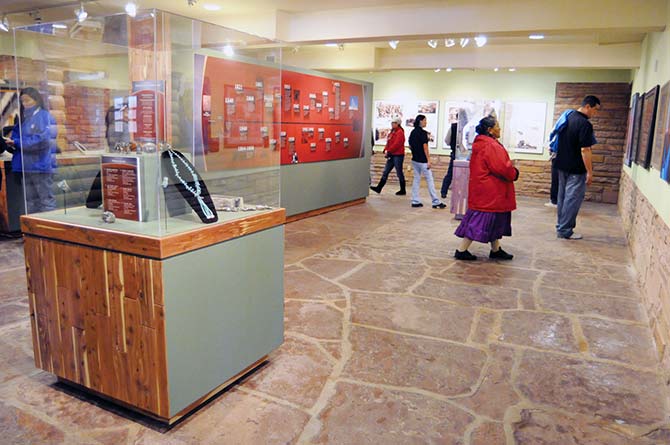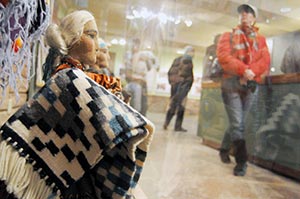Refurbished MV visitors' center tells people's story

(Times photo - Leigh T. Jimmie)
Visitors check out the exhibits at the remodeled visitor's center at Monument Valley Tribal Park on Dec. 9.
By Cindy Yurth
Tséyi' Bureau
MONUMENT VALLEY TRIBAL PARK, Dec. 17, 2009

(Times photo - Leigh T. Jimmie)
The newly remodeled visitor's center at Monument Valley Tribal Park opened Dec. 9 and provides a history of the Navajo people, the story of the Long Walk, a code talker exhibit and a collection of items from the Navajo Nation Museum.
People come to Monument Valley from all over the world to gawk at the scenery. But it's also many tourists' first - and possibly only - introduction to the Navajo people.
With a new $10 million upgrade to the tribal park's visitor center, the Navajo Nation is making sure they learn as much about the people as they do about the rocks.
"We got a lot of input from the local people about what they wanted people to see in these exhibits," said Navajo Nation Museum exhibit coordinator Clarenda Begay, who with other museum staff helped develop the exhibits in the remodeled center at the invitation of Navajo Nation Parks and Recreation.
"We've tried to tell the story not only of Navajos, but the Navajos who live in Monument Valley," she said.
There is but one plaque devoted to the geology of Tsé Bii' Ndzisgai (White Rock within the Rocks), as the locals know this place. And the scientific version shares the plaque with the Navajo version of how the valley was created.
According to a local medicine man, it was a muddy flood plain left when the people living here drained off a sea that bubbled up from the waterlogged Fourth World, until the Holy People decided the residents needed some landmarks and carefully placed each spectacular rock spire.
A plaque placed before a picture window admonishes visitors, "You are looking into a sacred landscape" and asks them to respect sacred sites within the park.
It's pretty clear this new visitors' center was designed by Navajos.
Other exhibits show Diné clothing, crafts, weaving tools, a family story from the Long Walk, the Navajo Code Talkers and the legacies of moviemaking and uranium mining. A large exhibit explains the three-branch Navajo Nation government.
There's a wall of what could be considered self-portraits: representations of Diné life and people by Diné artists.
"We've given people a taste of many aspects of Navajo culture," Begay said. "Hopefully it entices them to come farther into Navajo country and learn more."
Park Manager Herb Yazhe heralded the new center as "a big improvement" over the dingy and minimal exhibits it replaced. He credited Navajo Nation Parks and Recreation Department Manager Ray Russell for seeing the project through to completion.
"Finally, we have someone in there with vision," Yazhe said. "We've been putting money away since 2001 for this place."
According to Yazhe, the building dates to 1958, when the park first opened. Back then it was the ranger's quarters but it was converted into a visitors' center in 1960.
"There really haven't been a lot of improvements to it until now," he said.
Besides the remodeled and expanded visitors' center, the improvements included replacing outdated water and electrical lines. A new parking lot and toll booth are in the works. In addition to what Russell scraped together from the Parks & Rec budget, grants were obtained from the Navajo Capital Improvements Projects office, the Navajo Department of Transportation and ARTSCO, owner of The View Hotel.
The architect and contractors for the project were all Native-owned companies.
"Spectacular," pronounced Helen Webster at the facility's grand opening Dec. 9. As the manager of another tribal park, the Little Colorado River Gorge, she also confessed to feeling just a tad jealous.
"We've been told this is just the first phase of improvements for all the tribal parks," Webster said. "I can really envision a whole eastern entrance of the Grand Canyon at our park, with a visitors' center, hiking tours, even helicopter flights. Check us out in 10 or 15 years!"
In addition to Monument Valley and the Little Colorado, the tribe has parks or recreation areas at the Four Corners; the San Juan River near Bluff, Utah; Antelope Canyon; Bowl Canyon; and Window Rock. The Navajo Nation Council is considering legislation to ask Congress to turn Canyon de Chelly, a national monument, over to the tribe.

